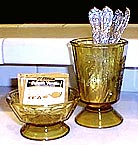![]()
For
a large selection of spooners available for sale
at the Pattern Glass Store, click HERE.
COLLECTING
SPOONERS
by
Dan Simmons
A popular collectible
today, the spooner or spoonholder, provided as much symbolic value as
function for Victorian society. The prominently displayed spoons were
a clear sign of ready hospitality, as well as a status symbol for the
increased affluence among the expanding middle class who could now afford
silver spoons, or at least a good facsimile. |
 A spooner in amber Wheat & Barley pattern by Bryce Brothers ca 1880s |
 An early decorated spoonholder in GRAPE VINE pattern. |
conventions,
interest in spoonholders had almost vanished by the 1930's. Today's collectible interest has generated a ready supply of old spooners for the secondary market. Made in a wide variety of metal, ceramics, and glass, you can tailor a collection to many individual criteria. From German silver to sterling silver, from stoneware to porcelain, from common depression glass to scarce art glass, spooners are once again in demand. A good number of spooners are absorbed into broader-based collections such as majolica, |
| flow blue, R. S. Prussia, Limoges, pewter, silver, carnival glass, opalescent glass, art glass, etc. Collections can also be very specialized, but the majority of collections are pattern glass because of its diversity and availability. Depending upon their condition and desirability, pattern glass spooners usually range in value from $10 to $200+, with the majority of clear, undecorated ones averaging in the $25-$45 range. Because some dealers at flea markets and malls do not recognize spoonholders, they are often mislabeled and underpriced. |  A very Victorian pattern called KITCHEN STOVE or JERSEY |
 A
spooner in the A
spooner in the fancy pattern called FESTOON. |
The beginning collector or dealer needs to observe closely and study to differentiate spooners from open sugars, sugar bottoms, celery vases, goblets, and tumblers. Spoonholders usually range in height from 4" for those with a flat base to 6" for those with stems. The height range for celery vases is usually from 6" to 9" for the taller stemmed pieces. Spoonholders are narrower and more |
| cylindrical
than sugar bottoms or open sugars. Unlike goblets, which always have a
smooth-rimmed lip, stemmed spooners are usually scalloped, serrated or
beaded at the top, and the stems are shorter. Though many flat-based spooners
have smooth rims, old tumblers tend to be slightly shorter and narrower
than spooners and are slightly flared toward the top. Though the mold shapes of spooners may vary greatly with the pattern, the distinctions |
 An ALASKA pattern spoooner by Northwood toward the turn of the 20th century. |
| above should be helpful for the beginner as he or she continues to acquire experience.Some dealers at malls and flea markets, either through ignorance or intentional deception will often put spoons in sugar bottoms, goblets, or tumblers and designate them as spooners. Just keep in mind as you search that everything that is capable of holding a spoon isn't necessarily a spoonholder. |
Pattern Glass Store, click HERE.
 |
 |
 |